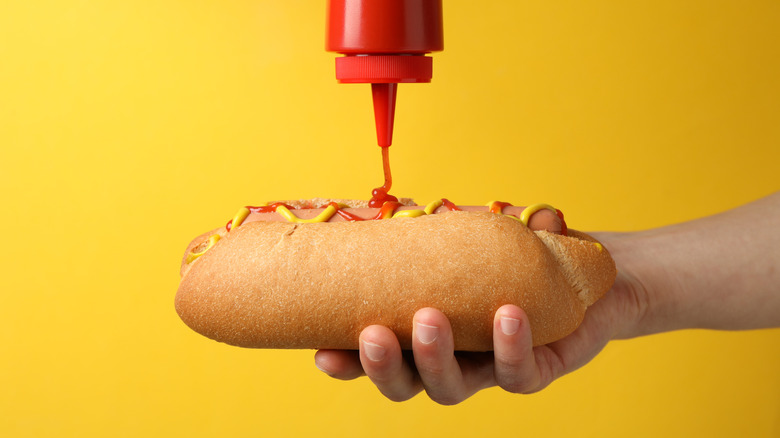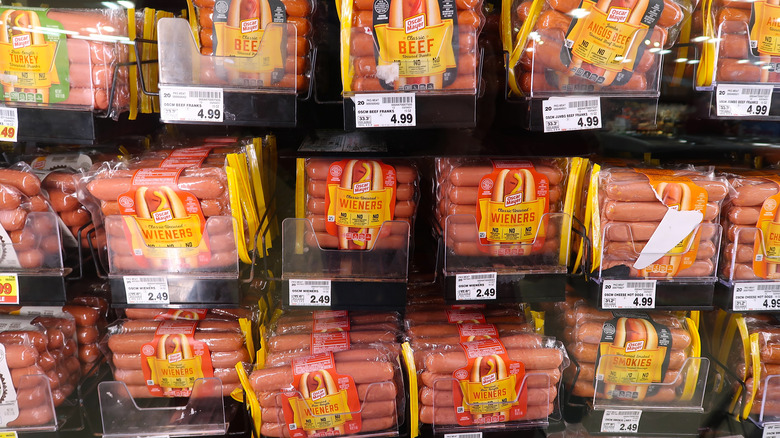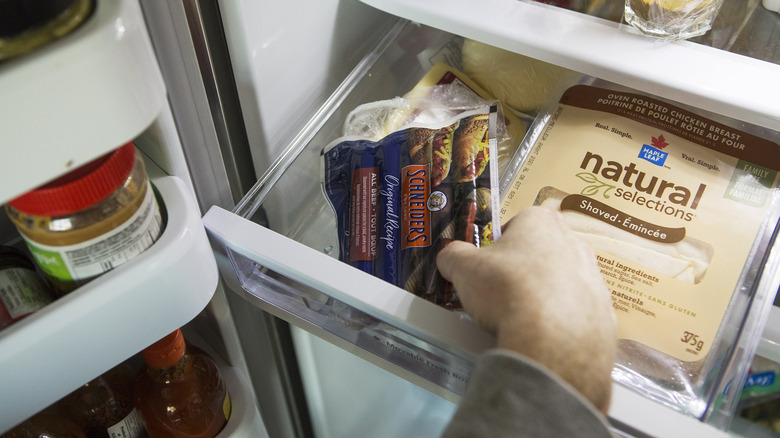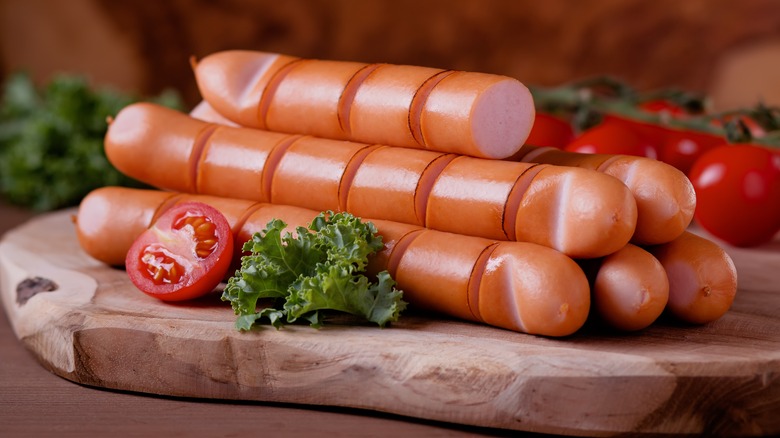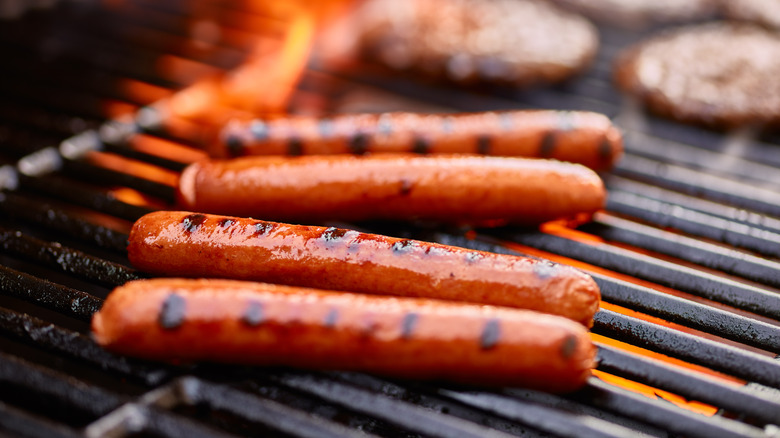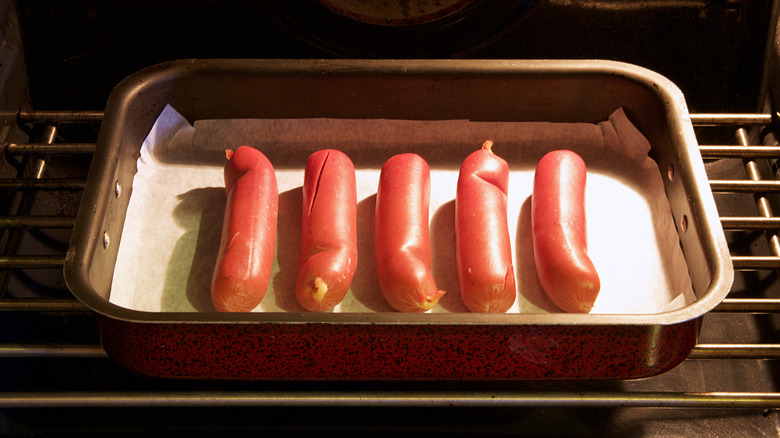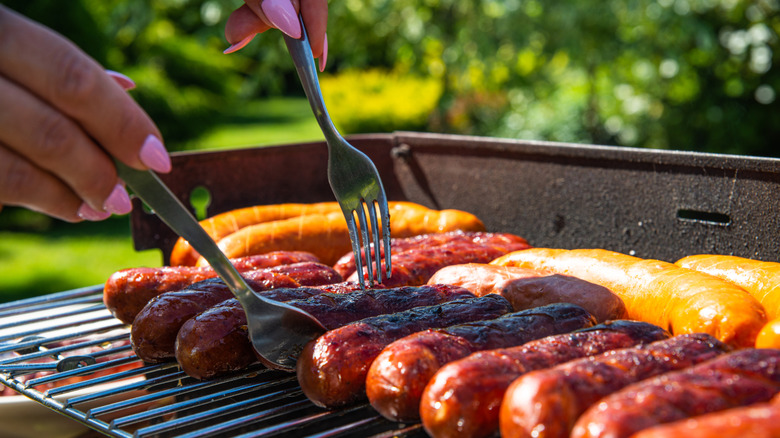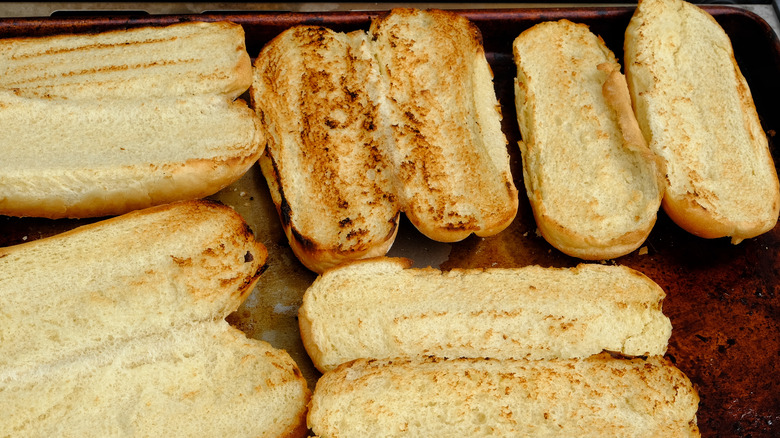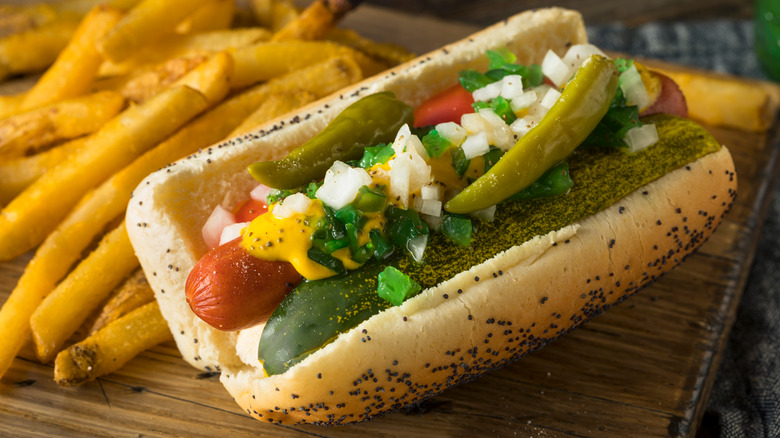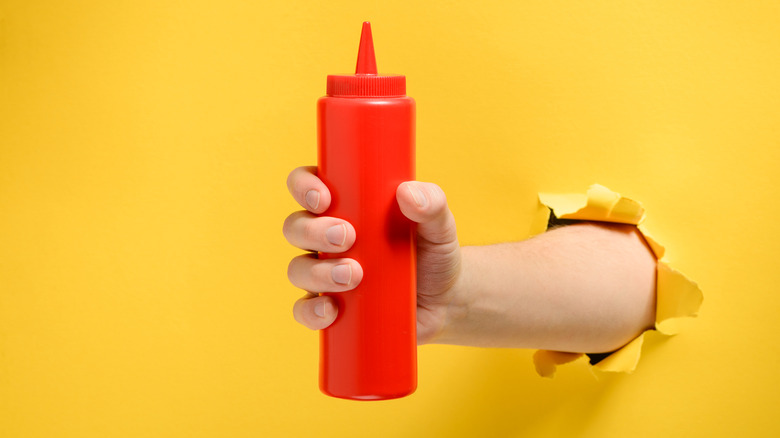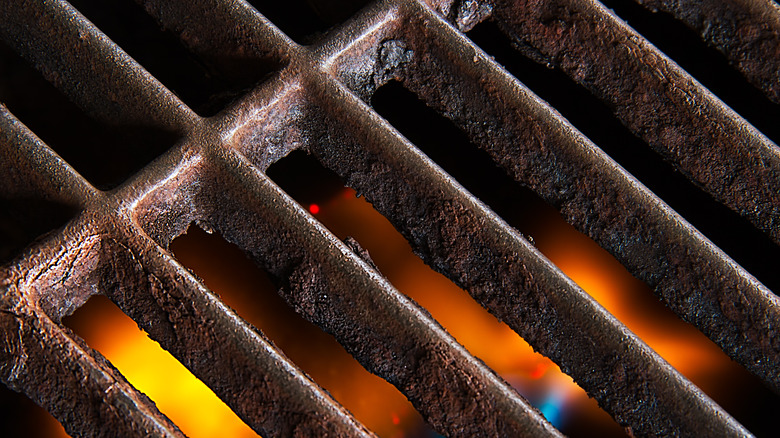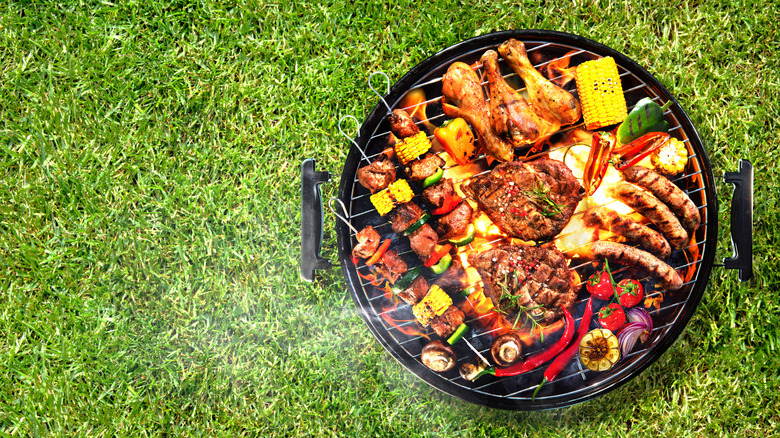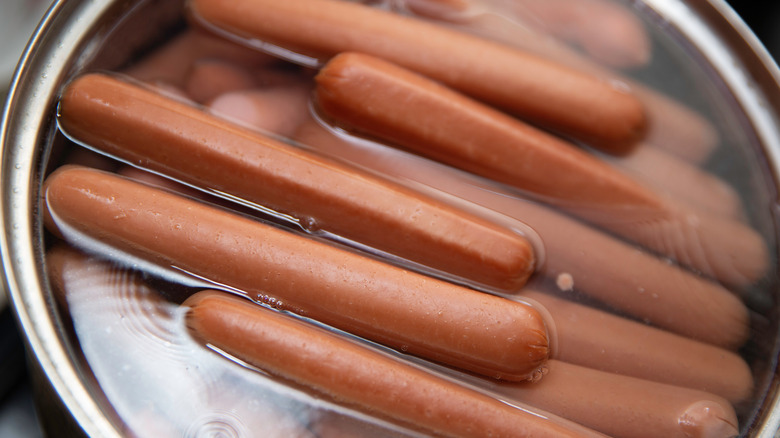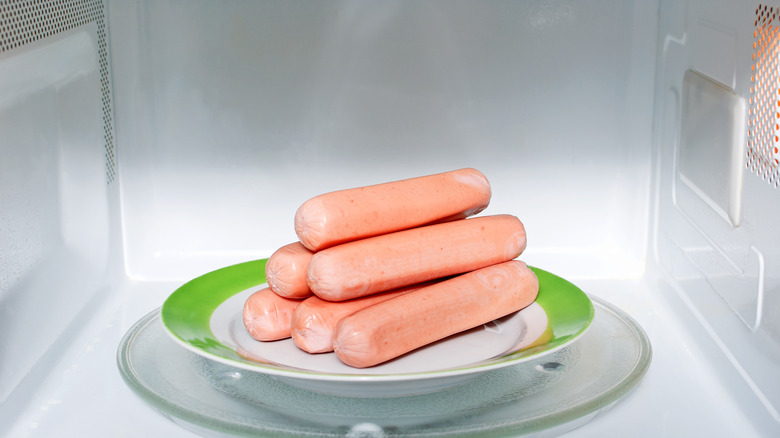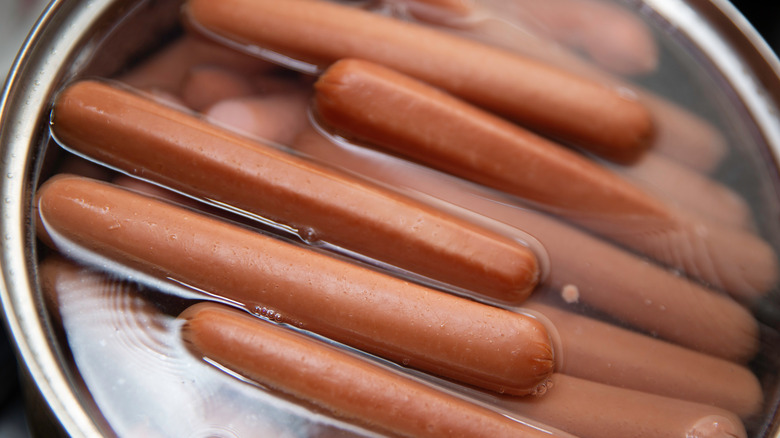Common Mistakes Everyone Makes With Hot Dogs
Already cooked when they come out of the package, hot dogs are a fairly foolproof food, and yet, people still manage to pummel them into brutal, unrecognizable forms — which, to be fair, still might taste okay. The mistakes we make with hot dogs are common, but that doesn't mean we should just let them fly.
The best thing about hot dogs is that they are a blank canvas for the every man. We should note that we have German immigrants to thank for how hot dogs are made; street vendors and Michelin-starred chefs alike have been known to serve up frankfurters. Hot dogs recall family reunions, baseball games, and summer vacations. They drown sorrows, pick up spirits, and go great with a beer.
Because hot dogs are so simple to prepare, it's easy to get impatient and thoughtless when making them. But a little bit of consideration goes a long way. There is no need to unfurl classic French techniques or conjure modern food wizardry. From avoiding cheap dogs to properly preheating the grill, minor details make a major difference in your final product. Consider the following common hot dog mistakes and how you can avoid them or address the underlying cause.
Choosing bad dogs
You might walk into the supermarket with the intention of buying good, quality hot dogs. But the siren song of cheap dogs is almost irresistible, beckoning you onto rocks made of preserved scrap meat. Jason and his Argonauts famously resisted the sirens' song by drowning it out with a better tune, and this should be your approach too. Some independent butcher shops make their own hot dogs, which are often far superior to the franks sitting in the cooler section of your local supermarket. There are also great regional hot dog brands out there with devout cult followings. In upstate New York, for example, different hot dog brands can each claim a stronghold in Buffalo (Sahlen's), Syracuse (Hofmann), and Rochester (Zweigle's).
If you aren't lucky enough to have a good regional brand or a nearby butcher shop that makes their own, grocery store hot dogs brands from Hebrew National and Nathan's Famous are far superior to the basic offerings from the likes of Bar-S and Oscar Mayer. Give different brands a shot and see which ones you like best. According to the New York Times, you'll want to pay close attention to the label when selecting your dog. Fewer ingredients mean a more wholesome experience. And, if you've ever bitten into a hot dog and felt a nice pop of resistance from the texture, you'll know you've landed on a good brand (via the Washington Post).
Not following food safety
We've all done it — stuck an opened package of hot dogs in the fridge and hoped they would last until next weekend, maybe the weekend after that. Well, according to the USDA, you may be rolling the dice in a gastrointestinal casino of your own design.
Hot dog safety starts right when you grab the package and stick it in your shopping basket. Being a "cold food" at the point of purchase — hot dogs should be kept cold until you can get them into your refrigerator. Unless a date on the wrapper says otherwise, an unopened package of hotdogs can safely be stored in a refrigerator for two weeks. After a package is opened, the USDA says hot dogs are good for one week. You can freeze hot dogs for up to two months without causing a significant drop-off in quality.
Avoid leaving hot dogs at room temperature for over two hours or more than one hour in temperatures above 90 degrees F. Even though hot dogs come fully cooked, the USDA recommends heating them until they are at least "steaming hot" before eating them. Doing this can reduce the threat from harmful bacteria called listeria monocytogenes.
Slicing or poking holes in the casing
Eating a split hot dog isn't ideal, and to avoid this, many people make a preemptive strike by poking holes in the casing. The thought process goes something like this: Holes will allow steam to escape in a controlled way and prevent full-on splitting — right? Not always. But, what if we told you that you can perfectly cook a hot dog with the casing still intact? There are no tricks, just simple techniques, such as slowly raising the heat of the dog. This method allows the casing to expand as fast as the meat inside (via Weber Grills).
While this can be done using indirect heat on a grill, a better approach is to slowly heat your hot dogs by poaching them in a shallow bath of flavorful liquid (via Meatwave). Start by placing a disposable aluminum pan over the grill's direct heat. Then, add a poaching liquid like stock or beer. Once the liquid simmers, move the pan off the direct heat and add your hot dogs. After the dogs are heated through, about 5 minutes or so, take them out of the pan and place them over the direct heat for a quick char. The result should be a juicy, flavorful, and fully intact hot dog.
Only using direct grill heat
Heat makes meat cook. We all know this. However, putting hot dogs on blast and calling it a day will cause you all kinds of problems. First, you are more likely to cause your casings to burst open, releasing flavorful juices from inside. Second, you're facing a higher potential of burning your dogs. If you like your hot dogs scorched, that may not be a problem, but if you are cooking for others — especially children — it's a good idea to have non-burned franks as an option.
You can easily avoid using only direct heat by establishing a two-zone grill. With a charcoal grill, place all of your hot coals on one side, leaving the other side for cooking with indirect heat. With a gas grill, turn on burners on one side of the grill, and leave the burners on the other side turned off. To avoid splitting open your casings, start your hot dogs on the side with indirect heat. Finish them off with a good char on the side with direct heat.
Sticking to the same old cooking methods
When most people cook a hot dog, they're grilling them, pan-searing them, or maybe even tossing them in the microwave. However, there are other options for cooking hot dogs out there. And no, we're not talking about boiling. Baking hot dogs in an oven is a great way to cook them evenly with very little effort. Start by preheating the oven to 400 degrees F. Place hot dogs in an ovenproof pan or tray, such as a casserole dish or roasting pan, lined with aluminum foil. Once the oven has reached the proper temperature, bake hot dogs for 15 minutes. Properly baked hot dogs should appear slightly curled and brown.
Another alternative way to cook hot dogs is to cook them in a pan with simmering water. Start by filling a pan with ¼ inch of room temperature water. Place the pan on your stove and turn on the heat. Once the water has begun to simmer, add your hot dogs. The water will eventually evaporate, and you should continue cooking the hot dogs in the dry pan until evenly toasted. The result will be nicely browned and juicy hot dogs.
Not considering the fat content
Averaging 190 calories and 17 grams of fat, hot dogs are not certainly considered a health food (via Better Homes & Gardens). However, there are some "lean" hot dogs available that maybe you can feel less guilty about eating. The Ball Park Lean Beef Hot Dogs contain just 80 calories and 5 grams of fat. Jennie-O Turkey Franks have 70 calories and 6 grams of fat, while Hebrew National 97% Fat-Free Beef Franks contain just 45 calories and 1 gram of fat. However, all of these dogs contain at least 380 grams of sodium and lots of preservatives.
If you are going to opt for a leaner dog, you need to adjust your cooking technique. While fattier meat can be cooked aggressively, lean meats should be cooked gently in order to keep them from drying out. This means grilling lean dogs is a tricky proposition. Better cooking options for leaner hot dogs include roasting them in an oven or cooking them in a pan with oil or liquid, as has been mentioned.
Not toasting the buns
Meat tube. Bun. A few toppings. Hot dogs are usually a pretty minimalist affair. To get the most out of each dog, you should be giving love to every single element, especially the bun. Toasted buns can seem like a luxury item that will get you kicked out of any barbecue involving a brother-in-law. Still, they are undeniably better than untoasted buns, and you should absolutely covet them. Buttered bread? What could be better?
The thing is, you shouldn't toast buns on the grill. They will soak up any disgusting grill residue, and the toasting can come out pretty uneven. A much better option is to toast hot dog buns in a skillet after brushing the split inside with a bit of oil or butter. If you're hosting a party, placing a sheet pan of split and oiled buns under a broiler is a good way to crank these babies out at volume. Regardless of how you toast, be sure to keep an eye on those buns to prevent burning.
Sticking to same old toppings
Food can have a transportive effect, and we leaned on this when COVID-19 kept us from traveling. A simple bowl of seafood gumbo took us to the mist-filled streets of New Orleans. Well-seasoned enchiladas triggered sweat-soaked memories of the American Southwest. Exploring the world through hot dog toppings isn't exactly like sailing the Seven Seas, but it's a lot cheaper, and there are as many options as there are islands in the Pacific.
In Sweden, hotdogs often get topped with mashed potatoes, cucumber, roasted onion, and a shrimp salad. In Chile, 'completo' hot dogs are topped with avocado, sauerkraut, tomatoes, chili, and cheese. In Colombia, common toppings include salsa, cheese, fries, and quail eggs.
The United States also has a rich tapestry of regional hot styles. In Kansas City, hot dogs are often topped with mustard, grilled sauerkraut, and Swiss cheese. In Cleveland, the 'Polish boy' hot dog is topped with French fries, coleslaw, and sweet barbecue sauce. In the Southwest, the Sonoran hot dog is wrapped in bacon, cooked, then topped with pinto beans, grilled peppers, grilled onions, chopped tomatoes, shredded cheese, mayonnaise, and mustard, relish, and green salsa. So, pick up a dart and throw it at the map — you're sure to land on a location with interesting hot dog toppings that can spruce up an otherwise ordinary meal.
Adding ketchup (especially in Chicago)
We could spend all day debating the merits of ketchup as a hot dog topping. However, there is a very real reason Chicagoans don't put ketchup on their hot dogs. According to many in the city, the addition of ketchup will ruin the flavors that initially draw you to eat a hot dog. While he did not make it an executive order, President Barack Obama famously said ketchup does not belong on a hot dog for anyone over eight years old. Esteemed local columnist Mike Royko said anyone who put ketchup on a hot dog "would be shaming themselves and their loved ones."
Chicagoans probably have a special place for ketchup-on-hot-dog people because the Chicago-style dog has such a firm grip on the city's psyche. The iconic dog consists of an all-beef frankfurter in a steamed poppy seed bun that is topped with mustard, onions, sweet relish, two tomato slices, two sport peppers, and a dill pickle spear, plus celery salt. From a culinary and logistical point of view, there's just no room for ketchup on a Chicago dog, and as those hot dog proud people believe, adding a sweet mess of sauce is bad manners — and bad for your tastebuds.
Not preheating the grill or oven
Preheating is the first step in just about every recipe. And yet, we're almost all guilty of forgetting to do it. You might think that you can just tack on a bit of extra cook time, but doing that often leads to underwhelming results. Extending the cooking time can cause your hot dogs to dry out and cook unevenly (via Weber).
A grill that hasn't been preheated properly also makes it more challenging to use the dual cooking method with both direct and indirect heat. Ideally, you should be moving your hot dogs back and forth between the hot and less-hot sides of the grill. When your heat is in a state of flux, properly heating and charring your hot dogs becomes unnecessarily complicated. Although it's more of an issue with hamburgers and steaks, placing hotdogs on a grill that hasn't been preheated can cause the meat to stick. Once your frankfurter is stuck to a grill, pulling it off can lead to disastrous results.
Overcrowding the grill
If you're grilling for a group of people, you're probably cooking multiple foods at once: hot dogs, hamburgers, chicken, corn on the cob. In this situation, you can quickly run low on real estate, and the temptation might be to cram as much food as possible to ensure everyone gets to eat simultaneously. Unfortunately, packing your grill to the gills is one of the most common mistakes people make when cooking hot dogs.
When you have a full grill, it's difficult to position and rotate your hot dogs so that they all get cooked evenly. Also, putting too much on your grill grates significantly reduces airflow and this can extend cook times. Finally, if you are cooking fatty meats, a packed grill makes it more difficult to deal with flame-ups,
Speaking with People magazine, barbecue expert Steven Raichlen recommended leaving about ¼ of the grill unoccupied, ideally in a location without direct heat. This empty space allows you to move quickly-cooking food away from direct heat and keep food away from flame-ups. Cook in multiple batches if you have to.
Grilling boiled hot dogs
Maybe people are worried about pathogens, or maybe they want to defrost a frozen hot dog, but despite this desire, it's generally a bad idea to grill boiled hot dogs. Sadly, it does happen, and it's a major mistake. In fact, most hot dog experts don't recommend boiling at all. The reason? Boiling a hot dog can water down a frankfurter's flavor. On its official company blog, Nathan's Famous says about boiling, "Honestly, we just don't recommend it."
If you're concerned about pathogens, you should know that hot dogs come fully cooked, and simply bringing them up to steaming-hot temperature is enough to kill off any stowaway pathogens (via FDA). If you're concerned about your hot dogs not being fully defrosted, better options include using the microwave or a pan filled with simmering water. If you want to get all fancy-like, go ahead and simmer them in something that will add flavor, like stock or beer. Just make sure your defrosting dogs are simmering, not swimming, in their pre-grill bath.
Not coating your hot dog in oil before grilling
We'd be lying if we said that not dipping your hot dogs in oil before grilling is a cardinal sin. But, iconic French chef Daniel Boulud takes grilled hot dogs to the next level by doing just that, among other things. At his now-shuttered restaurant DBGB in New York City, Boulud often used a dip in oil as a critical first step to cooking his house-made hot dogs. The oiled franks were then grilled on top of rosemary (to impart the herb's strong smoked flavor). Another key to the DBGB dog was a special sauce made of French-style mustard, American mustard, ketchup, and mayonnaise. Placed in a toasted bun, the hot dogs were then topped with house sauce, onion compote, pickled radish, carrot, jalapeno, garlic, sweet pepper, and daikon.
Of course, that involves a lot of components, and no one is expecting you to make hot dogs worthy of a Michelin Star. However, we gonna go ahead and say that putting a dry, non-oiled dog on a grill is a mistake, though one that you don't have to make.
Microwaving hot dogs can ruin your appliance
If you are pressed for time, it might be tempting to simply microwave your hot dog and be ready to eat in less than 5 minutes. However, microwaving can be bad for both your food and your microwave.
When foods with high amounts of minerals such as iron or magnesium are placed in a microwave, it can create a sparking effect known as "arcing" (via Discovery). Hot dogs, as you may know, contain a lot of additives. Some of these additives contain high amounts of minerals, per the USDA. Because of this, hot dogs are liable to arc when microwaved. While arcing itself doesn't ruin a hot dog, hungry eaters should avoid the phenomenon because it can damage the microwave. Therefore, if a hot dog is causing arcing, it makes it difficult to cook properly, and because uncooked dogs can contain harmful bacteria, you should never microwave a hot dog.
Overboiling is probably the worst thing you can do
Let's get this out of the way: Boiling probably isn't the best way to cook a hot dog. To be fair, it can be one of the more convenient cooking methods for a dog, and who are we to judge?
If you are going to boil your hot dogs, you should do it right. It's recommended that you add hotdogs to boiling water (not simmering, boiling) and let them cook uncovered for around 4 to 6 minutes (via Food52). Then, remove your hot dogs and place them on a plate lined with paper towels until they are ready to be served. If you are concerned about them getting cold, a low-heat steamer should be able to keep them warm without overcooking them.
Whatever you do, you shouldn't leave hot dogs in boiling water for more than 6 minutes or so. If you do, they will lose flavor, their texture will be off, and they might rupture, according to Lacademie. Since boiling is already a suboptimal way to cook hot dogs, overboiling them is pretty much the worst thing you can do to your wieners.
